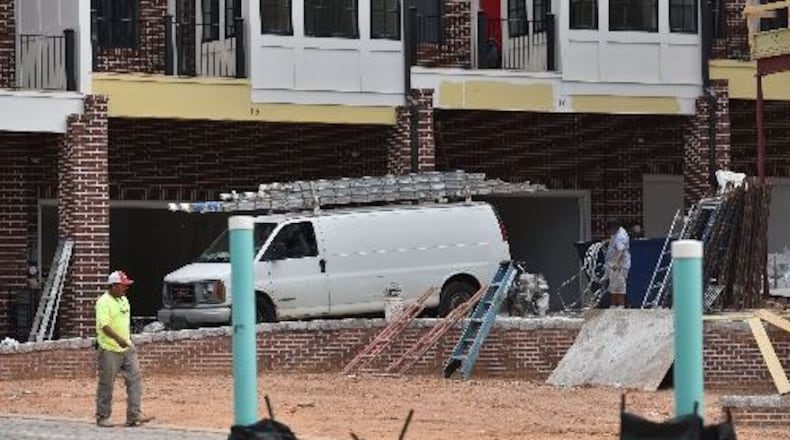The Atlanta BeltLine, one of the city’s hottest properties and increasingly home to housing costing half a million and up, is pushing hard to get hundreds of affordable housing units opened or in the pipeline in the coming months.
The stretch of trails and greenspace that will eventually make up the 22-mile loop inside the city has been a boon for home construction in Atlanta and has put the BeltLine in the bullseye of discussions about housing affordability.
While affordability and gentrification is an issue across the city, the Beltline has been seen as a driving force behind a renewed interest in Intown living. Once affordable communities along the BeltLine, such as Old Fourth Ward, are seeing housing prices start at $500,000 to $700,000 and up, and that has led to concerns that neighborhoods in the BeltLine's path — such as Adair Park or Vine City — could be next.
“Atlanta and a lot of cities in the southeast are starting to deal with the problems of housing affordability that places like Boston and New York have been tackling for while,” said Tina Lowe, president of the southeast division of Mercy Housing, whose organization recently opened a building for seniors on the BeltLine’s eastside trail.
The affordability problem is unlikely to be solved overnight.
Intown neighborhoods have become more attractive as millennials, seeking high-paying tech jobs, are moving into the city to be close to work in Midtown and Buckhead. Boomers are downsizing from their spacious homes in the suburbs after becoming empty-nesters. And everyone hates the metro area’s ever-exasperating traffic congestion, pushing many to see moving intown as a refuge from the snarls.
“We are at a stage now where we have to consciously plan,” Lowe said.
Mayor Kasim Reed in April created an anti-displacement fund targeted at Vine City, English Avenue and Ashview Heights . The goal is to help residents facing increasing property tax bills because of their proximity to the BeltLine and the new Mercedes-Benz Stadium. That same month, Invest Atlanta, the city's economic development arm, announced it was seeking requests for proposals to develop 24 single family properties for affordable housing on abandoned parcels in English Avenue and Vine City.
The Atlanta City Council last year adopted an ordinance that requires developers receiving public funding from the city to set aside 15 percent of units for affordable housing. And candidates hoping to succeed Reed as the city's next mayor have made housing affordability a prominent topic on the campaign trail.
Affordable housing is defined as housing costing tenants 30 percent or less of their net monthly income. The annual median income for a family of four in Atlanta is about $67,500.
Atlanta BeltLine Inc., which oversees the project’s operations, said that as of the end of 2016, it has invested $12.5 million in acquiring land for affordable housing, offering incentives to encourage developers to set aside affordable units and providing down payment assistance to homebuyers.
It has set a goal of creating 5,600 units of affordable housing by 2030 out of a total of 28,000 homes in the area. There are currently about 10,777 units —which includes apartments, single-family homes, condominiums and senior housing — in the area, including 785 affordable units.
One of those was Mercy Housing’s Reynoldstown Senior Residences, a building for low- and very-low income seniors near the eastside trail.
“With the final result, more than 70 seniors can now age in place on the Atlanta BeltLine in a neighborhood they can continue to call home,” Paul Morris, president and CEO of Atlanta BeltLine Inc., said.
Other affordable housing under construction includes Phoenix House, a development of 69 houses for the formerly homeless near the westside trail in southwest Atlanta, and the 160-unit Gateway Capitol View apartments near the Oakland MARTA station.
The second phase of the Lofts at Reynoldstown Crossing near the eastside trail will set aside 40 percent of units for affordable housing while 1016 Monroe will offer 20 percent of its units to affordable homes. BeltLine officials did not yet have total units on these projects and it was not yet known whether the properties would be for rent or for sale.
The BeltLine, hoping to underscore its commitment to affordable housing, released a video of residents at Reynoldstown Senior Residences praising the opportunity to live Intown affordably.
“The affordable rent was awesome for me,” said Reynoldstown resident Hester Wright, who grew up in the community but later moved to the suburbs. “I don’t have to worry now about yard work and paying for a plumber or roofing, things that I can no longer afford because my income has changed.”
Resident Frankie Hardman, a former Smyrna resident, said she heard about the building at her church, which is nearby. She said Reynoldstown offers seniors a community they can’t get when they have to drive everywhere for a visit. At Reynoldstown she and friends can walk to the theater, grocery stores and restaurants, without fighting traffic.
And there’s an extra bonus, she said.
“I have six granddaughters,” she said smiling as the video pans across the photos of toddlers to middle schoolers. “So when they come I’m going to take them out on the trail, burn off some of that energy, and bring them back in.”
MYAJC.COM: REAL JOURNALISM. REAL LOCAL IMPACT.
The AJC's Leon Stafford keeps you updated on the latest in the Atlanta mayoral race and everything else going on at City Hall. You'll find more on myAJC.com, including these stories:
Never miss a minute of what's happening in Atlanta politics. Subscribe to myAJC.com.
About the Author
Keep Reading
The Latest
Featured

